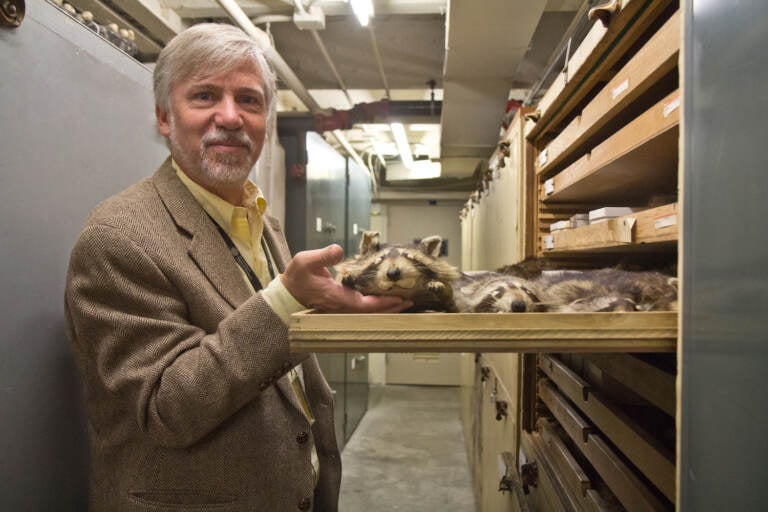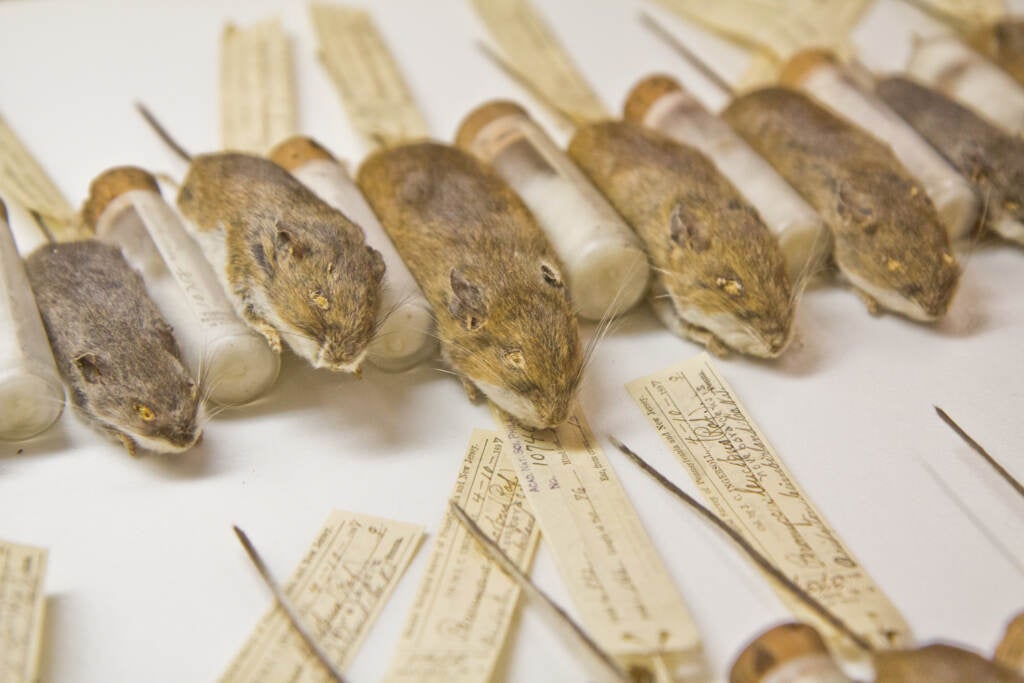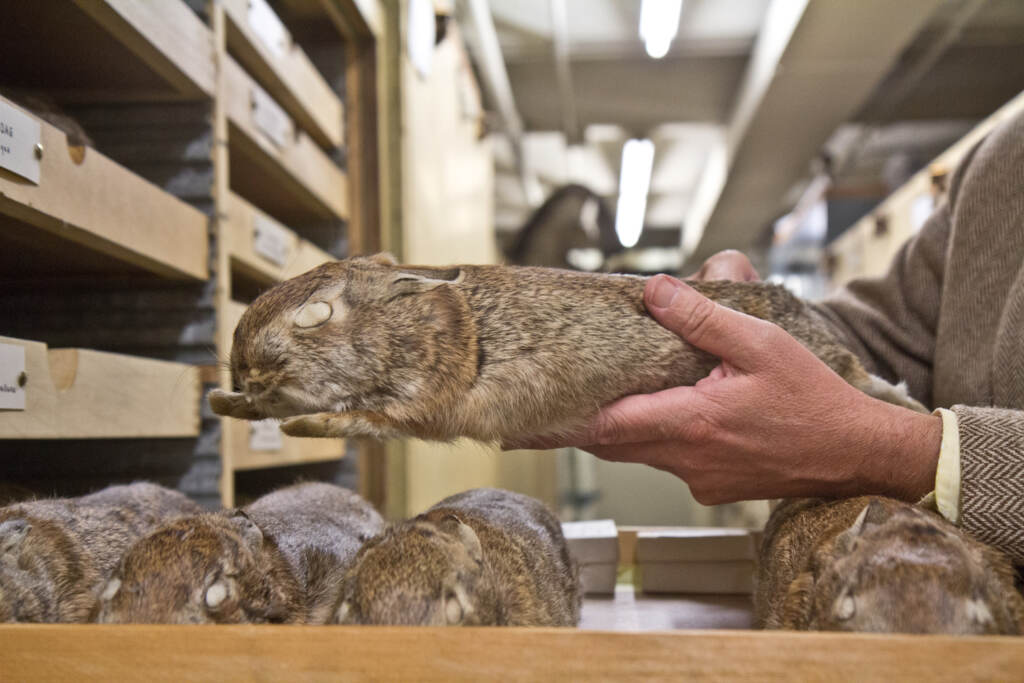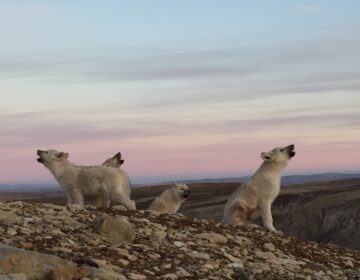Museums aren’t getting as many animal specimens. Scientists say that’s bad
The decline in new specimens is especially noticeable in the study of mammals. One journal article called it a “perfect storm” for the field.
Listen 9:16
Ted Daeschler, a curator and paleontologist at the Academy of Natural Sciences in Philadelphia, holds a raccoon specimen from the collection. DNA samples from specimens can answer questions about environments in history. (Kimberly Paynter/WHYY)
This story is from The Pulse, a weekly health and science podcast.
Find it on Apple Podcasts, Spotify, or wherever you get your podcasts.
Scientists document the diversity of life by making specimens of whole animals for natural history collections. But this practice is fading, and it’s a problem for current and future researchers.
For instance, the mammal collection at the Academy of Natural Sciences of Drexel University in Philadelphia, the oldest natural history museum in the U.S., dates back to the 1830s. But the museum has not had active research on mammals since World War II, said Academy curator and paleontologist Ted Daeschler, who is also a professor at Drexel University. The museum used to add hundreds of new mammal specimens to its collection each decade. That slowed down to the double, and later, single digits in the 1990s.
These specimens are important raw materials for research, Daeschler said. “These time capsules can teach us about conditions at that time and place in the past, which we would have really no way to quantify otherwise.”
The specimens show the size and shape and proportions of an animal, but they also preserve hair, skin, and other bits of DNA that scientists can use to study diseases, parasites, and even what chemicals were in the environment at the time. One research paper compares animal specimens to “biological filter paper.”

For example, the Academy has a collection of rabbits from Luzerne County, Pennsylvania — part of a project studying the ecosystem around a nuclear power plant. Future scientists may have new questions, and new tools to evaluate these samples.

The decrease in new specimens is bad news for scientists whose work relies on these collections, like Stephanie Smith, a postdoctoral research scientist at the Field Museum of Natural History in Chicago. She studies the spine architecture of mammals. An often-cited paper documenting this problem describes it as a “perfect storm” for the study of mammals.
“For example, we have skeletons of mammals that go back until the early 1900s. And so if people stop collecting because they say, ‘Oh, this museum has hundreds and hundreds of this particular type of animal,’ then we kind of lose that continuity,” she said.
Having fewer or missing specimens from the past few decades would be like having a big chunk of missing data about a time when the climate is changing quickly, and animals are going extinct. It’s like missing a few crucial pages from a diary.
But Smith said these specimens are important for other kinds of research, too, like discovering new species in a museum cabinet.
“When someone opens a new drawer and finds: we thought these were all one species of … sea star. And it turns out there’s seven.”
For instance, last December, some researchers looked at an old collection of shrews, small mole-like creatures, from Indonesia, to realize they had found 14 new species.
So, if this work is so important, why is there less of it in recent years?
Subscribe to The Pulse
The first issue is funding. It takes money to pay for the space, and work to maintain existing collections and collect new samples. A recent report from the National Academy of Sciences describes this work as undervalued and underfunded, often threatened with budget cuts or in some cases, being scrapped altogether. For example, more than 100 collections of preserved plant specimens in the U.S. have closed since the late 1990s.
Another question is whether researchers have to kill an animal for a specimen. Stephanie Smith at the Field Museum said this comes up often when she leads tours for children, but scientists have debated this too.
Smith and the other researchers I spoke to emphasize that there is a very strict permitting process, and scientists have to be very specific and deliberate about collecting only as many as are necessary and doing so humanely. They wouldn’t kill any endangered animals, for example.
But scientists do kill the animals because there is so much data that researchers cannot capture any other way: the internal organs, or an X-ray of a skeleton, for example.
Kevin Winker, curator of birds at the University of Alaska Museum of the North in Fairbanks, said that as a young researcher, he realized he “was actually releasing most of the data” each time he put a band on a bird and released it.
But killing an animal to add it to a collection is still a hard thing to do for scientists who study animals.
“When I actively collect a bird, I feel like a little bit of my karma just got chipped away,” Winker said. “I justify it mentally by recognizing when I do take a bird, I am putting it into a position to contribute for a very long time to … high-quality science … They are good for literally centuries.”
Smith said when she talks to children at the museum, she describes the specimens as ambassadors of their species, “so that it can be better known and better understood and better protected.”
There are some solutions to the shortfall in new specimens: Museums work with each other to fill in gaps in knowledge and put their specimens online, which helps if one collection is missing data about a particular time. There are databases that did not exist before, like crowd-sourced audio archives of bird songs. Congress actually approved funding for a network of over 80 field sites to collect data about animals, as well as their environments across the U.S. that started operating in the summer of 2019.
Kevin Winker said, ultimately, collecting this information benefits both animals and humans.
“If we can understand the changes that we’re causing to our co-occupants, we will be better managers of our own environments.”
WHYY is your source for fact-based, in-depth journalism and information. As a nonprofit organization, we rely on financial support from readers like you. Please give today.







